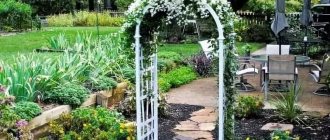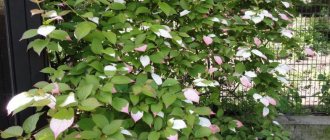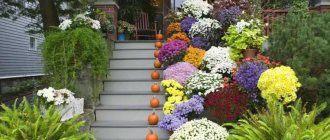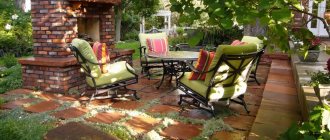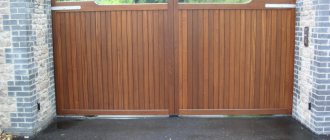Plant supports
Plant supports are natural or artificial bases and structures to support long shoots. Without them it is impossible to grow beautiful, healthy vines.
A high-quality foundation should be durable and look harmonious next to the garden crop. The type of support is determined before planting. The choice depends on the height and power of the shoots, the method and degree of attachment to the support. There are climbing, supporting vines, plants attached to the support with tendrils, leaves, and roots.
Two-plane trellises
Two planes for the vine can be constructed in different ways
Pay attention to our photos - there are many possible options for two-plane trellises. We will list the most popular ones so that you can choose the best model based on your own preferences and capabilities.
In addition, we will tell you what those who plan to build a two-plane trellis with their own hands should know about.
Simple two-strip trellis
Options for supporting the vine in two planes
Let's take a closer look at the types of two-plane trellises. They can be:
- V-shaped. The two planes are connected near the ground and gradually expand upward.
- Parallel. The planes are installed directly opposite each other.
- Y-shaped. This type of trellis resembles a V-shaped one, with the difference that at the ground itself they represent one plane, and begin to expand only at a certain height from the ground.
- Complex shape. The base of such trellises is Y-shaped, with canopies installed at the ends of each plane, looking in different directions.
Y-shaped trellis design
Thanks to the double planes, the grapes on such structures are in comfortable conditions. It is easier for the grapes to hide from the sun and piercing wind. Y-shaped trellises are popular among professionals. Despite the relatively complex design, they combine the advantages of single-plane and double-plane trellises. The vines in them are ventilated, and two planes diverging at an angle make it possible to grow grape varieties that give abundant growth and harvest. It is optimal to use such trellises for non-covering varieties, since it is not easy to remove vines for shelter for the winter from a Y-shaped trellis.
V-shaped trellises are quite simple in design and convenient
Construction diagram of a two-plane V-shaped trellis
In this section we will tell you how to make a V-shaped trellis with your own hands. We present the drawings, as well as the amount of material that will be required to construct one row, 3 meters wide. You will need:
- metal pipes for the base in the amount of 4 pieces, 2500 mm long;
- wire - about 30 meters;
- cement and sand;
- crushed stone
On the selected area you need to make markings using 4 pegs. As we have already noted, the length of the structure is 3 meters, width is 80cm. In each corner of the rectangle it is necessary to make a hole 0.5 m deep. In these recesses you need to insert support pipes, which are pre-treated with bitumen in the lower part. They must be moved in different directions at an angle.
The result should be a structure in the lower part of which the distance between the supports is 80 cm, in the upper part - about 120. If you look at it from afar, you can see its resemblance to the Latin letter V. The supports must be fixed with concrete. Next, you need to wait until the cement hardens well and only then continue working.
Now you can start stretching the wire. The lower tier should be half a meter from the ground, the next one should also be half a meter higher than the previous one.
Important: you need to secure the pipes well in the ground so that over time they do not tilt, becoming heavier from the harvest. It is also important to securely fix the wire on inclined supports using hooks or rings
Pipes for the trellis must be well fixed in the ground
DIY wicker fencing
Functional design in ethnic style is quite popular among gardeners and professional designers. To emphasize the color of the structure, you can mulch the currants with fir cones.
How to make a fence with your own hands:
- You need to prepare branches of medium thickness (about 10-15 pieces). They will become the core of the weaving.
- You will need a vine; it is better to take young shoots of poplar, alder or willow. Their structure is quite flexible.
- The ends of the stakes are sharpened. They are deepened near the bush in a circle or in a quadrangle, maintaining a distance of 20-25 cm. If the soil is soft, you can insert it with your hands, but into hard soil you will have to hammer it.
- Weaving starts from the bottom. The vine is planted alternately from the inside of the first pillar and the outside of the next one. This is done until the top of the support.
- The subsequent ones begin to weave from the adjacent peg, changing sides.
- Protruding ends that could not be hidden must be removed.
It is convenient to cut off excess parts with pruning shears
The density of the rows is determined independently. For currants, it is better to make the weaving sparse.
Bush holders
Every summer resident has done a standard bush holder at least once in his life, because it is impossible to calmly look at the branches of gooseberries, currants or heavy flowers that have fallen to the ground. For example, a do-it-yourself support for peonies can be made from plastic pipes, wooden blocks, or metal.
The easiest way to make bush holders is from wood, but under the weight of branches and the influence of weather conditions they can wear out and break, so they will need to be updated every 3-4 years. To make a bush holder with your own hands, you will need a wooden beam 30×30, 30×40 or 40×40 mm, a screwdriver, self-tapping screws, a hacksaw, paint or wood impregnation.
- Tie the branches and leaves of the bush with rope to avoid damaging them when installing the bush holder.
- Cut the timber into equal lengths and fasten them together into a square using self-tapping screws.
- Attach the legs to the corners of the square.
- Treat the structure with impregnation or paint for outdoor use.
- Place the bush holder on the bush and lightly dig in the supports.
- Untie the rope and distribute the branches of the bush over the support.
Supports for peonies must be installed in the spring, when the bushes are still small in size and their leaves and stems have not spread out, but supports for berry bushes should be made while they are still young and have flexible branches that are not burdened by the harvest.
DIY wooden fencing
If the support is made entirely of wood, it will not last long.
Some of the beams that are in the soil quickly become unusable. The support for the currant will have to be replaced with a new one after 3-4 years. If you make a fence entirely from timber, the upper parts are simply nailed to the lower ones. Important! To extend the service life, it is better to make the racks from metal. How to make a support with your own hands:
How to make a support with your own hands:
- Take four metal rods, measure the required length, and cut with a hacksaw.
- Two bends are made on the upper part.
- Prepared stands are stuck into four sides of the bush to form a square.
- The bars of the required length are measured and prepared using a hacksaw. Sharp corners can be ground off with a file or plane.
- Wooden blanks are placed in the hinges. The slats will lie in the bends of the two posts on opposite sides.
- The currant branches are pushed aside and the two remaining slats are placed behind the protrusions on the racks.
The fence is stable and strong
In autumn, the wooden parts can be removed and stored in the utility room.
Metal supports
The most basic solution to choosing a support for a vine is to purchase a metal structure. Garden stores offer a huge selection of similar products, which vary in design and cost.
More expensive products will last much longer than simple and flimsy supports.
The lightweight prefabricated support can be installed in any corner of your site by selecting the required dimensions. Such structures come in two types: flat (lattice) and arched.
Such a support will be an excellent place for the growth of many annual plants, such as sweet peas or morning glory, as well as climbing roses and clematis.
Welded metal supports are one of the strongest structures for climbing plants, because they are made of thick metal.
Metal supports can be welded in the form of flat picket fences, arches or garden obelisks; their shape can be absolutely any, it all depends on your imagination.
Small welded supports can be indispensable for seasonal use, while larger and more serious structures will help create a unique design for a personal plot.
The service life of such products is very long; with timely care, they can last more than 10 years.
Original garden supports for vines from handy and original summer residents
An original design made from bicycle wheels.
A simple arch made of birch trunks.
A simple design, but quite fundamental, where an arch is made of sanded logs and a metal fence element is used below as a support for clematis.
Supports for annual climbing crops made from branches in ECO style, popular today in Europe.
Arches
For zoning and decorating an area in gardens, arches entwined with climbing plants are often used. An arch can become an entrance to a site, a garden, a vegetable garden or a recreation area, or an element of a hedge. Depending on its size, it can accommodate benches, swings or shade-loving plants.
An arch on a site can be built from wood, metal, plastic pipes, or you can purchase a ready-made structure. Regardless of which option you prefer, the arch supports will need to be dug to a depth of at least 60-80 cm and concreted or secured in the ground with stones and bricks, since this structure has a strong windage and can be damaged by the wind.
You can also find arches made of stone; they are more durable than all others, but it is almost impossible to build one without preparation.
Although everyone chooses the size of the arch themselves, it should not be lower than 2.2 m and narrower than 1 m, because otherwise it will be difficult to pass through it after the plants have entwined the support. In order to make a metal arch yourself, you will need: a pipe with a diameter of 30 mm, a rod or fittings with a diameter of 6 mm and 10 mm, a tape measure, a pipe bender, a welding machine, a hacksaw, wire cutters, a hammer and a level. The work is performed in the following order.
- Cut 4 identical pieces of pipe for the supports.
- Bend a 10mm rod into an arc using a pipe bender (you need 2 or more identical parts).
- Weld them together using crossbars made of 6 mm reinforcement (crossbars can be straight, diagonal or bent into a ring).
- Dig the pipe supports into the ground and concrete them.
- Connect the supports to the finished arches.
- Paint the structure and plant climbing plants along the edges.
Popular articles Hydrangea Peppermint: description and features of growing the variety
Self-production of a straight single-plane trellis
Making your own single-plane support takes very little time. For fast and high-quality work, you must follow the following algorithm:
- At the site where the future fence will be installed, markings are made, the contours of the future support are outlined, and the cord is pulled.
- They dig a hole, 40-50 cm deep, and install a pillar in it. A wooden beam or a piece of log is used as a pillar; metal or PVC pipe; metal profile or corner. The length of the pole is 2.5 meters. The post is leveled vertically and the hole is filled with concrete.
- After the concrete has hardened, the post is marked to tension the cable. The first mark is made at a height of 50 cm, subsequent ones after 40 cm.
- Self-tapping screws are screwed into the wooden or polyvinyl chloride posts at the marking points. Holes with a diameter of 6-8 mm are made in metal posts and bolts are inserted.
- Having retreated 3 meters from the first one, install the following pillars.
- For horizontal tying, use a metal cable in a polyvinyl chloride sheath. It is attached to the posts using bolts or self-tapping screws.
On a note!
Before installation in the ground, metal poles are coated with an anti-corrosion compound, and wooden surfaces are impregnated with an antiseptic.
How to position?
Trellis structures are characterized by high windage, so they must be tightly and firmly fixed in the ground. Or they need to be buried deep enough in the soil. If the trellis accidentally falls, the plants may die. You can consider securing a trellis using the example of a pyramidal trellis for roses.
Take two long boards, 6 m each, slats, a saw and screws. 1 m is cut from the boards, the remaining part is divided in half. You should now have four boards of 2.5 m each and two boards of 1 m each. The boards are split into slats 4 cm wide. Now you can assemble the pyramid with self-tapping screws. All that remains is to plant roses on all trellis sides. This structure is simply strengthened in the ground, but if there is any doubt about the weight of the future harvest, the trellis goes into the ground 50 cm in columns and is filled with concrete.
How to do it yourself?
To begin with, you should think about what kind of trellis you want to get at the end - what shape it will be, what size it will be, where it is best to install it. It is advisable to consider several options rather than grab the first one that comes to mind - this way the result will be better. At the next stage, you need to draw up a drawing in which you must indicate all the dimensions. All calculations should be double-checked several times beforehand and only then start working.
We have already discussed above the advantages and disadvantages of different materials. In the conditions of your own site, it is logical to choose the raw materials that are available (do not require money for purchase) and which you personally can process at home. This will most likely be wood.
Assembly is carried out in the most convenient way - wooden parts are most often connected with nails or similar fasteners, while it is most reasonable to weld metal. In this case, the wood is impregnated with protective compounds before assembly, so that the protection penetrates even into future seams, but painting the iron structure is relevant already in assembled form.
Trellis are usually not so heavy that they have to be concreted - most often they just need to be dug into the ground to a sufficient depth. The sufficiency criterion strongly depends on the height of the product - the higher the trellis and the greater its windage, the deeper it must be dug, but the final position in any case must be reliable and stable. If you are constructing a volumetric (not flat) arch with more than two legs, you can not dig it in so deeply. Moreover, such a large-scale structure will be a priori heavier, which is why it is assembled after the first supports have been dug into the ground.
New life for old items and antiques
Time passes, and many household items and things that were once considered irreplaceable are sent to landfills or dusty storage facilities, forever forgotten by their owners. If you are throwing away household appliances, furniture or interior items, look at them carefully first. Quite large elements in the garden can be used in a new way, continuing their indoor career as an unusual support for plants.
Old wooden spinning wheels or sewing machine looms can be an excellent alternative to stakes for tying up large perennials. Ladders, stepladders and their equivalents, especially if you emphasize that you are using them for other purposes, will cope with the task of supporting any vine. Even an old sideboard, shelving, wall bars, easels and machines, exercise equipment, shelves, a sideboard, a chest of drawers or chairs can change their purpose to a purely practical task. Craftsmen even manage to remove the “stuffing” from televisions and refrigerators, washing machines and other equipment, and place the body as a support in gardens with nostalgic notes.
In order for the change of purpose to be successful, and for your new garden decor to serve as a support for more than one season, you just need to take care of the correct processing of materials. Fortunately, there are many means to protect wood, metal, and plastic from corrosion and bad weather.
These are just a few of the possible categories of original supports. If you wish, you can even create trellises in the form of a surfboard, a fence made of giant colored pencils or graceful ballerinas made of wicker vines that will support clematis no worse than an arch...
An old cart used as a stand for garden plants. kataz
Conical and pyramidal supports
For small areas it is convenient to use a metal or wooden support in the shape of a cone. They are on sale, but making them yourself is also easy. We install pegs in a circle around the plant. We collect them in a bun from above and secure them.
By analogy with a cone, a pyramid-shaped support is made. The only difference is the square base. To make the plant “climb” to the top faster, we tie a mesh of tight thread in several places between the supports.
Forming grapes on a trellis
The fan-sleeve design is considered one of the most comfortable. It is necessary to plant the seedlings correctly so that the upper eye is 7-10 cm deep into the ground. If you use this method, the formation of a trunk is excluded, the vine will easily bend to the soil.
The correct formation of grapes is achieved by several years of periodic work on them.
In the first year, the main goal is to obtain four high-quality shoots from the seedling. Weak shoots must be removed immediately so that the bush does not waste additional energy on them. In autumn, the plants are shortened to 80-100 cm. If no standing shoots have grown, you can remove them all and leave 5-7 buds on the bush, and repeat the steps next year.
The following year in the spring, the shoots are tied to a wire like a fan. On these plants you need to grow 2 new shoots. All eyes break off after swelling, leaving only the top two. All other shoots, which may sprout periodically in the summer, break off. The first harvest may appear, but you should not leave more than half a bunch on the sleeve. The main goal is to form a powerful bush, so all fruit loads should be applied to it gradually. Fruiting links are expected to appear in the fall. On the lower shoot, 2-3 buds are removed, the next one loses 7-10 buds. Before the winter cold, the vine is covered with earth.
In the third year of life of the grape bush, all the resulting shoots are tied horizontally to a wire on a trellis. On the replacement shoot, cut off all the inflorescences except two, one of which should be placed away from the center; it will become the replacement shoot next year. In autumn you can get a harvest of 5 kg or more.
Every year you need to remove the fertilized vine, this will ensure a constant increase in yield.
DIY rockeries. Photos and article about it here.
Here is an article about how to create a discount with your own hands.
And in this section https://ru-house.net/landshaft/ there is a lot of interesting information about the landscape.
Wire for grape trellises should have a high zinc content over the entire surface. Thanks to its spraying, it can last 3 times longer than a regular one. Zinc with a density of about 230 g/m² improves the anti-corrosion properties of the material.
The relative elongation of the wire for trellises is about 5%. This is a good indicator, unlike other options. The negative impact of temperatures does not manifest itself clearly, the wire sags less, so it needs to be tightened less often. The increased carbon content makes the wire stronger, which extends its service life.
Following all the rules for creating trellises for grapes and making the correct formation of the shoots. You can create a wonderful composition with your own hands, which will become a decorative part of the garden path, gazebo, while simultaneously providing a good harvest of fruits every year.
Do-it-yourself trellis for grapes in the country
Copyright "Vsadu.ru" 2010-2017 Copying and modification of site materials is possible only with the written consent of the copyright holders. Articles are protected by the law on copyright and related rights; when quoting materials from the Vsadu.ru project, a direct open link to vsadu.ru is required. All rights reserved.
We can notify you about new articles so that you are always aware of the most interesting things.
Continue No thanks
Benefits of using custom plant supports
Many elements are responsible for the vertical structure of the garden, its expressiveness and dynamics - dominants, skeletal plantings, small architecture, and accent plants in each individual composition. But in the vertical game there is no more interesting tool than support structures for garden plants. And we’re not just talking about climbing, twining or climbing stars: both perennials and seasonal stars, whose flowers are too heavy for fragile shoots, need support. Even small supports for peonies or vines can perform a completely unexpected function.
Supports for vines can bring not only grace, airiness, expressiveness and structure to the garden, but also at the same time play the role of a full-fledged decor, style-forming decoration or an element that attracts the eye. Using a variety of supports you can:
- express your character and tastes;
- remind about hobbies and hobbies;
- make a statement about your position or life views;
- bring a feeling of luxury;
- create a special atmosphere.
The supports perform both aesthetic and practical tasks. The former are often ignored, since the main motive for purchasing or creating supports for plants is always purely practical. Supports are needed if you want to support crumbling bushes or fragile flower stalks, reveal the beauty of climbing roses or clematis, create a colorful screen from prying eyes, or drape boring and dull walls, creating living canopies and cascades.
But whatever the task that is solved with the help of a supporting structure, it is not at all necessary to implement it in a boring way. After all, the chance to bring something unique to the garden does not come around very often.
Popular articles How to care for irises in August - September
The original structures that play the role of support for plants are difficult to classify or cover unambiguously. They can be anything - in style, shape, size, materials and aesthetic value. If the support fulfills its main function and at the same time seems to be an original decoration that better reveals the nature of the design of your garden, then it can be included in the ranks of non-standard and acceptable.
Plant supports serve both aesthetic and practical purposes
Rope supports
The simplest do-it-yourself support for climbing plants can be made using ordinary twine or thin rope, both natural and plastic. Such a support is usually located near the wall of a house, gazebo or barn and is intended for climbing ornamental or garden plants. It is simple to implement, but has a number of disadvantages. Firstly, the support made of twine is unaesthetic and looks poor, and secondly, it is not very strong and can break under the load of green fruit. And finally, it is short-lived, and every year the rope will have to be cut and reattached.
If you want to quickly make a support for climbing plants with your own hands, then simply drive nails into the wall under the roof or secure anchors, and tie twine to them, to the bottom of which you can tie the plants. You can place such a support on both the southern and northern sides of the house, depending on the preferences of the crop that you plan to plant.
Why do you need a support for flowers and for what crops is it needed?
Support is required for many plants. For indoor types, it is a decorative and practical detail. Support is required for species with leaves that are not elastic enough to support weight, as well as with fragile and climbing shoots.
Important! Support ensures proper and healthy growth. Her core allows her to do this.
Support is required for:
- plants that form aerial roots (philodendron, monstera);
- plants with long shoots (stephanotis, dipladenia, jasmine);
- for tall plants (Araliaceae);
- for those plants in which all their beauty is shown only when they are tied up (ivy, cissus).
Only with support will these plants grow correctly.
Kinds
All existing supports can be divided into two main types.
Decorative
This design is in itself a real decoration of the garden. You can even do without flowers. Thanks to the forged product, the garden will look like a fairy-tale meadow next to the castle. And if you also choose a beautiful flower for it, you will get a truly delightful composition. This type of support includes arches, pergolas, nets, and garden screens. The latter deserve special attention, because they are decorated with turrets and sculptures, which makes a simple support look like a work of architectural art.
Technical
As the name implies, these supports perform only their main function - supporting the plants so that they do not fall. Technical supports include supports such as wire or mesh. However, this division is conditional. Modern nets look so beautiful that they can easily decorate any garden.
There is another way to classify existing supports. In this case, they look at what plants are supported.
Supports for indoor plants
Inexperienced gardeners often believe that indoor plants do not need supports, and that flowers will grow well on their own. But in fact, indoor flowers also need supports. This is especially true for plants with large leaves or long stems. For indoor flowers, supports made of metal-plastic, plastic or thin wood are usually chosen. For example, next to an orchid or a green tree, a thin bamboo stick tied with twine or decorated with moss looks great. In specialized stores you can choose supports of any height, diameter and strength. This means that you can fix the plant in pots, flowerpots, and plant pots.
For garden plants
Garden plants make the yard more cozy. The same can be said about properly selected supports. This design (whether round or conical) gives the flowers shape and allows them to control their growth. In the garden, supports made from natural materials look most natural. These could be wooden supports or even stones found in the garden.
Such supports can be roughly divided into two more subtypes: artificial (man-made wooden fences, polished supports in the form of a cone) and natural (branches of nearby bushes or trees, pebbles). Unlike a small house or apartment, a garden really has space and possibilities. There is no need to limit your imagination to one pot of orchids. You can build a base in the form of arches, arbors, or even create entire walls entwined with ivy or roses.
If the plant climbs upward, then it is better to install high poles or a metal wall next to it. This would work for lemongrass, hops or honeysuckle. Plants such as climbing roses need support with large cells. It is also stretched horizontally. If the plant has tendrils (ivy, hydrangea, and maiden grapes belong to this group), then it will weave along any surface. The main thing is that it is rough so that the antennae can be securely fixed on it. But for plants such as princelings, cucumbers, and green beans, a lot of free space is needed. Therefore, it is worth installing wide nets next to them as a support.
For garden crops
So-called useful plants also need support. The right support will not only turn an ordinary tomato bush into part of a large garden, but will also increase the yield. Not only simple arches or pergolas, but also unique mini-greenhouses are suitable for growing garden crops. In this case, the support is the main wall. If necessary, it is supplemented with metal mesh or rope fastenings. For growing tomatoes, asparagus, beans or cucumbers, the same coconut support made of durable fiber is suitable.
In this case, the area or room will definitely look aesthetically pleasing.
Making your own support
In addition, you can make a beautiful support of the desired design, size and shape. To work, you will need available tools and a minimum set of tools. You should also decide on the material. Making a product is not difficult, especially if you find a project on the Internet with a detailed description and photo. Let's look at how to make flower supports from different materials.
Metal structures for flowers
To create a metal support structure, gardeners most often use metal mesh due to its practicality.
It is secured to a fence, pole or facade. The material is sold in rolls in specialized stores. First you need to decide on the size of the piece. To do this, you need to decide whether the material will partially or completely cover the surface. Next, markings for fastenings are applied. Holes are drilled and self-tapping screws are inserted onto which the mesh is attached. The metal mesh is convenient because it is practically invisible behind the flowers. If you have a welding machine, then you can build a more complex, but beautiful option from metal. For example, a structure in the form of a pyramid, slanting grilles, awnings over the veranda, curved arches.
PVC water pipes, fittings, iron rods, wire - all this is suitable for creating support for flowers. The metal strips and pipes are first sanded, primed and painted. The pillars are fixed to the surface of the earth using concrete. It is recommended to paint it green, black or white. Forged products are also used.
Plastic pipe supports
Plastic is a practical, easy-to-install material. The structure is attached to the wall of the house or buried in the ground. To give strength, they are concreted. They make plastic supports for plants in the form of arches, trellises, trellises. You will need a piece of plastic tube, fishing line and sphagnum moss.
Below is an algorithm for making supports for bushes, shrubs and flowers:
- Take a polypropylene pipe of the required length.
- Wrap a thick layer of moss 10 centimeters wide around it. In this case, the part that will be in the ground must be left open.
- Compact the wet moss and tie it with fishing line.
- Do the same to the top of the plastic product.
- At the end you need to tie a knot and melt it with a match.
- Make staples from wire.
- Attach the plant stems to the finished structure.
A trellis is also convenient for climbing plants. It is a combination of several plastic trellises connected to each other. Such a structure will provide a pleasant shade. And if you make a ceiling, you will get a good gazebo.
Wooden flower supports
Because wood is an environmentally friendly, durable material, it is often chosen to create support for plants. The following tools will be useful for the job: sandpaper, hammer, nails and saw. You will also need special impregnation against moisture, moisture-resistant paint.
The design is made in the form of:
- Fence. To implement this option, you need boards 1.5-3 meters high and crossbars that are nailed down. If you vary the length of the boards, you get an interesting “wave” effect.
- Pyramids. You will need four sticks of the same length. They are nailed together so that the letter L is formed. Next, three crossbars are fixed between them, which will serve as a support for the plants. Having connected all the panels, the product is deepened into the ground, and a plate is nailed on top.
- Vertical wall. With this type of support, the flower container is placed at the bottom. Take wooden beams and cut the panels to the required length. They are fastened in the form of a rhombus or square. To decorate the corner of the apartment, you should rotate two panels at an angle of 90 degrees and attach strips to the sides.
Bamboo plant supports
It is easy to build structures for grapes of any geometric shape from bamboo. For example, arches, ladders. Ropes are used to secure the jumpers. If the bamboo trunk is strong, it can be used as a pole. A stick of a certain thickness is inserted into the ground and fixed using special clamps. Such products are ideal for supporting large, short and long climbing plants. To protect parts from moisture, they are coated with varnish. To give the product strength, it is recommended to cover bamboo supports with plastic.
With the help of bamboo supports it is easy to build an obelisk for clematis, guide a vine shoot, and support a rose. These products are suitable for most types of plants. They look beautiful and natural among the green foliage.
Grape growing practice
Traditionally, grapes are grown in the southern regions: here the plant does not need shelter in winter. In the south, trellises are not always used. For example, in Central Asia and the Middle East, vines are simply placed on the surface of the soil. America and Europe are characterized by supportless standard culture. Often in the Caucasus, a large tree is simply used as a support, around which grapevines are placed.
But with the development of technologies for growing this berry, as well as with the improvement of frost protection methods, the plant began to actively spread to the north. Supports are also useful, helping to preserve the strength of the grapes for abundant fruiting. The principles of the support structure depend on several factors.
Of course, such a young plant does not yet need trellises, but it should be planted taking into account the fact that there is enough space for this structure
Including from:
- planting schemes;
- plant varieties;
- technology of pruning used.
Taking these circumstances into account, suitable trellises are selected.
If grapes are planted on the site for the first time, it is not at all necessary to immediately use stationary trellises; it will be enough to build temporary supports. But it is not recommended to delay the installation of a stationary structure. In the third year, the first harvest can be expected from planting the plant. By this time, the bush itself should be fully formed, and its root system reaches a fair size. If you start building a trellis during this period, it may have a negative impact on the plant.
Original configurations
The shape of the trellises differs in variety. Arched, double-plane and single-plane structures are in demand. Many gardeners prefer V-shaped and T-shaped varieties.
Simple variations include a single-plane product, including two parallel supports with tensioned cables. Two-plane trellises have bases that are arranged crosswise and have a short and upper longer crossbar. Rows of wires are attached to the ends of the elements. Particularly popular are vertical and lattice structures, which are good for guiding climbing plants. The internal parts have fine-mesh structures or consist of thin parts that are arranged crosswise. The choice of configuration depends on the location of the trellises.
Materials for supports
The most inexpensive supports are made of plastic.
They are not subject to rotting, mobile, durable, and thanks to the variety of sizes, shapes and colors, they easily fit into the design of any area. However, plastic also has disadvantages: it is too light, does not withstand the weight of large vines well, and can break under the influence of wind. Popular articles The use of paving slabs in landscape design
Fiberglass is a type of plastic that is highly durable. It is used to make single trellises, pyramids, support pegs, and bush holders. The elastic material tolerates temperature changes well, does not suffer from moisture, and holds heavy branches and plant stems well.
Supports painted green are suitable for the garden; they blend in with the foliage and can be combined with any design solutions.
Supports made from wicker also look impressive; they will complement the area well in a distinctly natural style. To ensure that the wood lasts as long as possible, it is impregnated with antibacterial compounds, painted, and covered with yacht varnish.
The durability of the supports also depends on the type of wood. All conifers have good resistance: larch, spruce, pine. High-quality structures are made of oak, but their price is too high. Birch is not suitable for garden structures: products made from it quickly deform.
Metal supports are considered the most durable. They can withstand the weight of bulky bushes and tree-like vines of any size. There is no need to dismantle structures for the winter. Anti-corrosion coating or painting will help extend the service life. Metal structures can be quite inexpensive, assembled from scraps of a pond, grate, or corner. Those who prefer more elegant solutions will like custom-made forged supports; they will become a real decoration of the site.
Types of trellises, main characteristics
By type of material, trellises are divided into:
- metal;
- wooden;
- plastic;
- from the mesh;
- from available materials (wire, fishing line, rope, etc.).
The metal trellis is considered the most durable. It is well suited for heavy plants such as grapes and fruit-bearing plants. For dachas, wooden trellises are very popular. The structure of the tree fits well into the landscape design with its naturalness and environmental friendliness. Plastic, wood, and wire are often used to make trellises for indoor plants.
Types of structures are divided according to the type of foundation:
- single-plane;
- two-plane;
- horizontal;
- decorative.
If the first three are intended to increase the productivity of agricultural land and vineyards, then the last type has a purely decorative function.
Decorative garden trellises are very diverse:
- square;
- rectangular;
- triangular;
- arched;
- trellis obelisk;
- ladder;
- wall;
- with diamond-shaped cells;
- with square cells;
- fan;
- diamond;
- chevron;
- mill;
- round;
- with ground stand,
and many others, it all depends on imagination and creativity.
Types of trellises
To ensure normal growth and good fruiting for the grapes, it is necessary to install reliable supports in each vineyard. Gardeners call these posts with wire stretched between them trellises.
Growing grapes on a trellis provides a number of advantages:
- The area of the site is saved due to the fact that the plants are tied vertically upward.
- Provides better illumination of the leaf mass and accelerates photosynthesis. The berry harvest becomes much higher. Grape clusters have time to ripen better and gain higher taste.
- Good ventilation is provided, which reduces the incidence of grape diseases and reduces the need for spraying with various chemicals.
In the first two to three years, the functions of trellises can be successfully performed by long stakes with ropes or nylon cords stretched between them.
During this time, it is necessary to have time to install permanent supports and stretch ordinary steel wire or a thin cable between them.
1.1. Single-plane trellis
Beginners usually start with a single-plane trellis. It is simple to make, it gives good results and does not require significant costs for the purchase of materials and installation.
But in this case, the vines grow in a somewhat cramped space, interfering with each other. Sunlight only hits the outer leaves and photosynthesis does not occur as quickly as on two-plane trellises.
1.2. Two-plane trellis
These trellises consist of two single-strip trellises installed next to each other and inclined from each other at a slight angle. If we look from the end, we will see the Y symbol.
The difference between a two-plane trellis and a single-plane trellis is clearly visible in this photograph. The leaves of the grapes do not shade each other. Good ventilation inhibits the spread of powdery mildew and other diseases.
When using two-plane trellises, the yield per 1 sq. meters will be higher due to the increased load on the grape bush. At the same time, if the same load is allowed on a single-plane trellis, then the berries may simply not ripen until frost occurs.
Design for cucumbers
Cucumber is a climbing vegetable. For its growth, summer residents very often install supports. For a cucumber trellis, the size of the bed and the garden itself, as well as the material from which the structure will be made, are important.
We offer simple options for the following designs:
The bed is 9 meters. You need three posts or poles up to 3 meters high, 5 cm in diameter, two 4.5 meter slats, a roll of twine or mesh, pegs, nails and a tape measure.
Instructions:
- We bury three support pillars. We leave 2.5 meters of support above the ground. We bury the pillars 4.5 meters from each other. The structure is designed to hold a considerable weight of fruits and greens, so it should be reliably strengthened.
- We connect the upper parts of the pillars with slats.
- If there is a trellis net, we secure it between the spans with ropes or wire. If not, we hammer nails onto the posts and bend them into a hook shape. Stretch the twine, leaving a distance of 20 cm between the hooks.
- We hammer a peg at each proposed planting site.
- From the bottom peg we pull the twine to the top rail. We get a mesh grid.
The second option is a wooden trellis. It is a decorative element and at the same time a lattice for cucumbers.
We will need poles for supports (at least 2 pieces) with a diameter of 5 cm and a length of 3 meters. For the crossbar, rake handles (2 pieces) of the desired length and diameter of 4 cm will be used. Wooden slats are 3 cm wide, the number of which can be calculated by dividing the height of the structure by 15 cm (cell width). The lower crossbar will be located at a height of 40 cm from the ground.
Instructions:
- We install support pillars.
- We fix the crossbars with self-tapping screws.
- We fasten the vertical slats to the crossbars with nails every 15 cm.
- We nail the horizontal slats to the supports every 15 cm.
- In some places we additionally knock the slats together.
- We cut off protruding slats, if any, with a hacksaw.
Remember!
Types of supports for climbing plants
The division of supports into three types - small architectural forms, wall structures and solitary plants - is important, but a slightly different classification is much more practical. After all, the installation of an arch, although it belongs to small architecture, is much closer to an obelisk or pyramid than to a heavy pergola
Depending on the decorative purpose and functional purpose, the following are distinguished:
Supports used for landscaping vertical planes
When choosing a support for a climbing plant that is planned to be planted near a fence, gazebo, house wall and used in facade landscaping, it is worth remembering that growing directly on a building and fences, using the most basic structure as a support is not the best option.
The point is not only that the natural mechanisms that provide the vines with the opportunity to cling to support are sometimes so strong that they can destroy the walls and materials themselves, but it is also a matter of sanitary standards. The green mass will increase the humidity under the vine, leading to greater corrosion and wear of coatings and materials, not to mention the consequences of creating an ideal environment for pests and fungal diseases.
Caring for wall coverings, especially when it comes to the facade of a house, will be complicated and often impossible, as will repair work. Therefore, when landscaping walls, buildings, structures and fences with vines, it is better to use additional support, which will only be close, but not closely located on the landscaping surface.
Growing climbing plants on mesh or linear supports, wooden and plastic trellises, trellises and guide cords, rather than directly on the structure, will minimize damage and achieve the goal without depriving yourself of the ability to properly care for coverings.
It is better to select the type of wall supports according to the type of vine. Thus, wild grapes or hydrangea will easily climb along guide cords or wire mesh, while ivy will prefer trellises, trellises, etc.
The distance to the walls should be minimal, but within reasonable limits. For wooden structures, it is advisable to place gratings and other supports nearby 30 cm from the wall. And for metal, stone, artificial surfaces, concrete and brick - at least 40 cm.
Supports for clematis planted along the wall of the house
Supports for separately growing climbing plants - tent forms
The tent form of cultivation is conventionally called any cultivation of tapeworm vines, which involves placement on an independent support - as a separate, beautifully silhouetted vertical element in space. On pyramids, obelisks, spheres, arches, climbing plants are placed near recreation areas or above a bench, near a path and above it, creating picturesque passages, and are also included in the design of flower beds and ridges.
The design and type of materials are chosen in accordance with the massiveness and weight of the vine itself, and the decorative qualities are chosen depending on whether the structure itself will be visible and what its role is in creating the completed image.
Supports for creating hedges and screens from climbing plants
Creating screens or green walls from climbing plants is possible thanks to wooden or mesh supports - shields, trellises, trellises - wide-mesh meshes installed or stretched between reliable “columns”.
Synthetic supports are increasingly replacing wooden structures, gratings and meshes are being replaced by cables stretched between reliable posts, but the essence of such supporting elements does not change. Not only are they suitable for lighter, more flexible and easier to form vines, but they also require secure attachment to base supports.
Large and massive architectural supports
We should also consider the most massive supports - pergolas, open gazebos, inclined supports and green tunnels
Strong and high wooden beams, fastened at the top with horizontal crossbars, a powerful frame made of metal support pipes holding shields or a “roof” that is completely covered by vines, look impressive and always attract attention
But creating such structures is a more difficult task than installing a simple arch. The supports for a pergola or tunnel must be securely fixed in the soil, and connecting individual parts into a single architectural element requires special skills.


